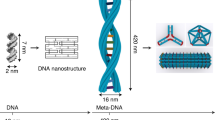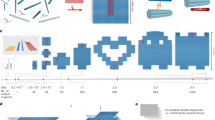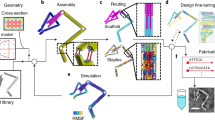Abstract
Molecular self-assembly offers a ‘bottom-up’ route to fabrication with subnanometre precision of complex structures from simple components1. DNA has proved to be a versatile building block2,3,4,5 for programmable construction of such objects, including two-dimensional crystals6, nanotubes7,8,9,10,11, and three-dimensional wireframe nanopolyhedra12,13,14,15,16,17. Templated self-assembly of DNA18 into custom two-dimensional shapes on the megadalton scale has been demonstrated previously with a multiple-kilobase ‘scaffold strand’ that is folded into a flat array of antiparallel helices by interactions with hundreds of oligonucleotide ‘staple strands’19,20. Here we extend this method to building custom three-dimensional shapes formed as pleated layers of helices constrained to a honeycomb lattice. We demonstrate the design and assembly of nanostructures approximating six shapes—monolith, square nut, railed bridge, genie bottle, stacked cross, slotted cross—with precisely controlled dimensions ranging from 10 to 100 nm. We also show hierarchical assembly of structures such as homomultimeric linear tracks and heterotrimeric wireframe icosahedra. Proper assembly requires week-long folding times and calibrated monovalent and divalent cation concentrations. We anticipate that our strategy for self-assembling custom three-dimensional shapes will provide a general route to the manufacture of sophisticated devices bearing features on the nanometre scale.
This is a preview of subscription content, access via your institution
Access options
Subscribe to this journal
Receive 51 print issues and online access
$199.00 per year
only $3.90 per issue
Buy this article
- Purchase on Springer Link
- Instant access to full article PDF
Prices may be subject to local taxes which are calculated during checkout




Similar content being viewed by others
References
Whitesides, G. M., Mathias, J. P. & Seto, C. T. Molecular self-assembly and nanochemistry: a chemical strategy for the synthesis of nanostructures. Science 254, 1312–1319 (1991)
Seeman, N. C. Nucleic acid junctions and lattices. J. Theor. Biol. 99, 237–247 (1982)
Fu, T. J. & Seeman, N. C. DNA double-crossover molecules. Biochemistry 32, 3211–3220 (1993)
Li, X. J., Yang, X. P., Qi, J. & Seeman, N. C. Antiparallel DNA double crossover molecules as components for nanoconstruction. J. Am. Chem. Soc. 118, 6131–6140 (1996)
Seeman, N. C. DNA in a material world. Nature 421, 427–431 (2003)
Winfree, E., Liu, F., Wenzler, L. A. & Seeman, N. C. Design and self-assembly of two-dimensional DNA crystals. Nature 394, 539–544 (1998)
Yan, H., Park, S. H., Finkelstein, H., Reif, J. H. & LaBean, T. H. DNA-templated self-assembly of protein arrays and highly conductive nanowires. Science 301, 1882–1884 (2003)
Rothemund, P. W. et al. Design and characterization of programmable DNA nanotubes. J. Am. Chem. Soc. 126, 16344–16352 (2004)
Mathieu, F. et al. Six-helix bundles designed from DNA. Nano Lett. 5, 661–665 (2005)
Liu, D., Park, S. H., Reif, J. H. & LaBean, T. H. DNA nanotubes self-assembled from triple-crossover tiles as templates for conductive nanowires. Proc. Natl Acad. Sci. USA 101, 717–722 (2004)
Yin, P. et al. Programming DNA tube circumferences. Science 321, 824–826 (2008)
Goodman, R. P. et al. Rapid chiral assembly of rigid DNA building blocks for molecular nanofabrication. Science 310, 1661–1665 (2005)
Chen, J. H. & Seeman, N. C. Synthesis from DNA of a molecule with the connectivity of a cube. Nature 350, 631–633 (1991)
Zhang, Y. & Seeman, N. C. The construction of a DNA truncated octahedron. J. Am. Chem. Soc. 116, 1661–1669 (1994)
He, Y. et al. Hierarchical self-assembly of DNA into symmetric supramolecular polyhedra. Nature 452, 198–201 (2008)
Zhang, C. et al. Conformational flexibility facilitates self-assembly of complex DNA nanostructures. Proc. Natl Acad. Sci. USA 105, 10665–10669 (2008)
Shih, W. M., Quispe, J. D. & Joyce, G. F. A 1.7-kilobase single-stranded DNA that folds into a nanoscale octahedron. Nature 427, 618–621 (2004)
Whitesides, G. M. & Grzybowski, B. Self-assembly at all scales. Science 295, 2418–2421 (2002)
Rothemund, P. W. Folding DNA to create nanoscale shapes and patterns. Nature 440, 297–302 (2006)
Yan, H., LaBean, T. H., Feng, L. & Reif, J. H. Directed nucleation assembly of DNA tile complexes for barcode-patterned lattices. Proc. Natl Acad. Sci. USA 100, 8103–8108 (2003)
Douglas, S. M. et al. Rapid prototyping of three-dimensional DNA-origami shapes with caDNAno. Nucleic Acids Res (in the press)
Mandelkern, M., Elias, J. G., Eden, D. & Crothers, D. M. The dimensions of DNA in solution. J. Mol. Biol. 152, 153–161 (1981)
Diekmann, S. & Lilley, D. M. J. The anomalous gel migration of a stable cruciform: temperature and salt dependence, and some comparisons with curved DNA. Nucleic Acids Res. 15, 5765–5774 (1987)
Budker, V., Trubetskoy, V. & Wolff, J. A. Condensation of nonstoichiometric DNA/polycation complexes by divalent cations. Biopolymers 83, 646–657 (2006)
Hibino, K. et al. Na+ more strongly inhibits DNA compaction by spermidin(3+) than K+. Chem. Phys. Lett. 426, 405–409 (2006)
Garcia, H. G. et al. Biological consequences of tightly bent DNA: the other life of a macromolecular celebrity. Biopolymers 85, 115–130 (2007)
Harris, J. R., Gerber, M., Gebauer, W., Wernicke, W. & Markl, J. Negative stains containing trehalose: application to tubular and filamentous structures. Microsc. Microanal. 2, 43–52 (1996)
Douglas, S. M., Chou, J. J. & Shih, W. M. DNA-nanotube-induced alignment of membrane proteins for NMR structure determination. Proc. Natl Acad. Sci. USA 104, 6644–6648 (2007)
Jungmann, R., Liedl, T., Sobey, T. L., Shih, W. & Simmel, F. C. Isothermal assembly of DNA origami structures using denaturing agents. J. Am. Chem. Soc. 130, 10062–10063 (2008)
Acknowledgements
We thank X. Su for assistance in cloning M13-based scaffold sequences and G. Hess for pilot studies on the railed-bridge design. This work was supported by a Claudia Adams Barr Program Investigator grant, a Wyss Institute for Biologically Inspired Engineering at Harvard grant, and an NIH New Investigator grant (1DP2OD004641-01) to W.M.S., a Humboldt Fellowship to H.D., Deutscher Akademischer Austauschdienst (DAAD) Fellowship to T.L., and Swedish Science Council (Vetenskapsrådet) Fellowship to B.H.
Author Contributions S.M.D. designed the monolith and square nut, and provided caDNAno software support; H.D. designed the stacked cross; T.L. designed the railed bridge; B.H. designed the slotted cross; F.G. designed the genie bottle; W.M.S. designed the icosahedron; S.M.D. and W.M.S. developed the honeycomb-pleated-origami design rules; H.D., S.M.D., T.L., B.H. and W.M.S. optimized the folding and imaging conditions. All authors collected and analysed data and contributed to preparing the manuscript.
Author information
Authors and Affiliations
Corresponding author
Ethics declarations
Competing interests
[Competing interests: W.M.S. is listed as inventor on a patent filed by Dan-Farber cancer institutes, entitled ‘Wireframe Nanostructures’ for the wireframe icosahedron described in Fig. 4, in April 2007.]
Additional information
The authors declare competing financial interests: details accompany the paper on www.nature.com/nature.
Supplementary information
Supplementary Information
This file contains Figures s1-s12 with Legends, Supplementary Materials and Methods and Supplementary Data (PDF 13130 kb)
Rights and permissions
About this article
Cite this article
Douglas, S., Dietz, H., Liedl, T. et al. Self-assembly of DNA into nanoscale three-dimensional shapes. Nature 459, 414–418 (2009). https://doi.org/10.1038/nature08016
Received:
Accepted:
Issue Date:
DOI: https://doi.org/10.1038/nature08016
This article is cited by
-
Soluble and multivalent Jag1 DNA origami nanopatterns activate Notch without pulling force
Nature Communications (2024)
-
Harnessing a paper-folding mechanism for reconfigurable DNA origami
Nature (2023)
-
Digital nanoreactors to control absolute stoichiometry and spatiotemporal behavior of DNA receptors within lipid bilayers
Nature Communications (2023)
-
Site-directed placement of three-dimensional DNA origami
Nature Nanotechnology (2023)
-
Gene-encoding DNA origami for mammalian cell expression
Nature Communications (2023)
Comments
By submitting a comment you agree to abide by our Terms and Community Guidelines. If you find something abusive or that does not comply with our terms or guidelines please flag it as inappropriate.



